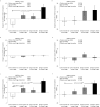Omega-3 index and blood pressure responses to eating foods naturally enriched with omega-3 polyunsaturated fatty acids: a randomized controlled trial
- PMID: 32963294
- PMCID: PMC7508802
- DOI: 10.1038/s41598-020-71801-5
Omega-3 index and blood pressure responses to eating foods naturally enriched with omega-3 polyunsaturated fatty acids: a randomized controlled trial
Abstract
Diets low in seafood omega-3 polyunsaturated fatty acids (PUFAs) are very prevalent. Such diets have recently been ranked as the sixth most important dietary risk factor-1.5 million deaths and 33 million disability-adjusted life-years worldwide are attributable to this deficiency. Wild oily fish stocks are insufficient to feed the world's population, and levels of eicosapentaenoic acid and docosahexaenoic acid (DHA) in farmed fish have more than halved in the last 20 years. Here we report on a double-blinded, controlled trial, where 161 healthy normotensive adults were randomly allocated to eat at least three portions/week of omega-3-PUFA enriched (or control) chicken-meat, and to eat at least three omega-3-PUFA enriched (or control) eggs/week, for 6 months. We show that regular consumption of omega-3-PUFA enriched chicken-meat and eggs significantly increased the primary outcome, the red cell omega-3 index (mean difference [98.75% confidence interval] from the group that ate both control foods, 1.7% [0.7, 2.6]). Numbers of subjects with a very high-risk omega-3 index (index < 4%) were more than halved amongst the group that ate both enriched foods. Furthermore, eating the enriched foods resulted in clinically relevant reductions in diastolic blood pressure (- 3.1 mmHg [- 5.8, - 0.3]). We conclude that chicken-meat and eggs, naturally enriched with algae-sourced omega-3-PUFAs, may serve as alternative dietary sources of these essential micronutrients. Unlike many lifestyle interventions, long-term population health benefits do not depend on willingness of individuals to make long-lasting difficult dietary changes, but on the availability of a range of commonly eaten, relatively inexpensive, omega-3-PUFA enriched foods.
Conflict of interest statement
J.K. and H.H. are full-time employees of Devenish Nutrition. The salaries of A.V.S. and F.O.D. have been in part funded by Devenish Nutrition. A.V.S and M.M.B. own stock in Devenish Nutrition. A.G.F. has consulted for Devenish Nutrition and received compensation. K.J., F.B., K.S., T.E.S, N.P., S.A.M.T., N.M., D.J.W. and E.D. declare no potential competing interests.
Figures




Similar articles
-
Fortification of foods with omega-3 polyunsaturated fatty acids.Crit Rev Food Sci Nutr. 2014;54(1):98-114. doi: 10.1080/10408398.2011.578221. Crit Rev Food Sci Nutr. 2014. PMID: 24188235 Review.
-
Australian food sources and intakes of omega-6 and omega-3 polyunsaturated fatty acids.Ann Nutr Metab. 1999;43(6):346-55. doi: 10.1159/000012803. Ann Nutr Metab. 1999. PMID: 10725768
-
Omega-3 polyunsaturated fatty acids-enriched hen eggs consumption enhances microvascular reactivity in young healthy individuals.Appl Physiol Nutr Metab. 2018 Oct;43(10):988-995. doi: 10.1139/apnm-2017-0735. Epub 2018 Apr 10. Appl Physiol Nutr Metab. 2018. PMID: 29633621 Clinical Trial.
-
Effect of Food with Low Enrichment of N-3 Fatty Acids in a Two-Month Diet on the Fatty Acid Content in the Plasma and Erythrocytes and on Cardiovascular Risk Markers in Healthy Young Men.Nutrients. 2020 Jul 24;12(8):2207. doi: 10.3390/nu12082207. Nutrients. 2020. PMID: 32722083 Free PMC article. Clinical Trial.
-
Where to find omega-3 fatty acids and how feeding animals with diet enriched in omega-3 fatty acids to increase nutritional value of derived products for human: what is actually useful ?J Nutr Health Aging. 2005 Jul-Aug;9(4):232-42. J Nutr Health Aging. 2005. PMID: 15980924 Review.
Cited by
-
Designing Nutrition for Health-Incorporating Dietary By-Products into Poultry Feeds to Create Functional Foods with Insights into Health Benefits, Risks, Bioactive Compounds, Food Component Functionality and Safety Regulations.Foods. 2023 Nov 1;12(21):4001. doi: 10.3390/foods12214001. Foods. 2023. PMID: 37959120 Free PMC article. Review.
-
The beneficial effects of omega-3 polyunsaturated fatty acids on controlling blood pressure: An umbrella meta-analysis.Front Nutr. 2022 Aug 18;9:985451. doi: 10.3389/fnut.2022.985451. eCollection 2022. Front Nutr. 2022. PMID: 36061895 Free PMC article.
-
Effects of Omega-3-Rich Pork Lard on Serum Lipid Profile and Gut Microbiome in C57BL/6NJ Mice.Int J Food Sci. 2022 Nov 22;2022:9269968. doi: 10.1155/2022/9269968. eCollection 2022. Int J Food Sci. 2022. PMID: 36458205 Free PMC article.
-
Nutrigenomics of Dietary Lipids.Antioxidants (Basel). 2021 Jun 22;10(7):994. doi: 10.3390/antiox10070994. Antioxidants (Basel). 2021. PMID: 34206632 Free PMC article. Review.
-
Can Omega-3 prevent the accidence of stroke: a mendelian randomization study.Hereditas. 2024 Sep 5;161(1):30. doi: 10.1186/s41065-024-00329-9. Hereditas. 2024. PMID: 39232799 Free PMC article.
References
-
- Chowdhury R, et al. Association of dietary, circulating, and supplement fatty acids with coronary risk: A systematic review and meta-analysis. Ann. Intern. Med. 2014;160:398–406. - PubMed
-
- Wu A, Ding Y, Wu F, Li R, Hou J, Mao P. Omega-3 fatty acids intake and risks of dementia and Alzheimer’s disease: A meta-analysis. Neurosci. Biobehav. Rev. 2015;48:1–9. - PubMed
Publication types
MeSH terms
Substances
LinkOut - more resources
Full Text Sources
Research Materials

